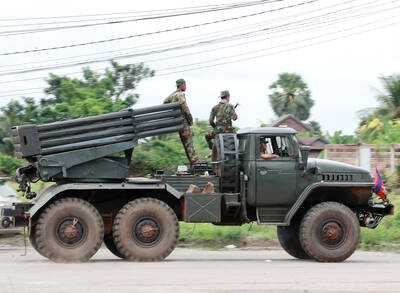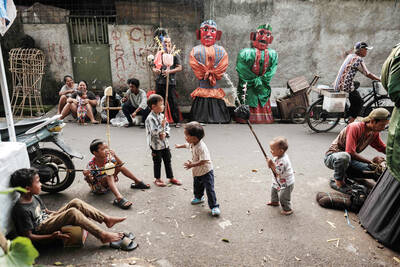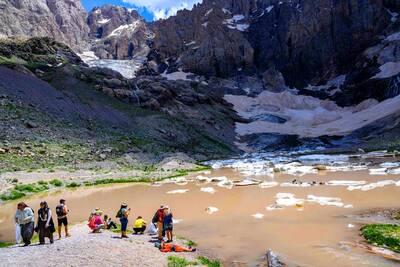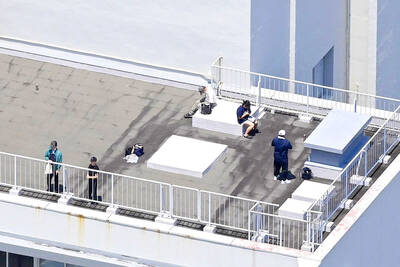Al-Qaeda’s North African branch claimed to have killed at least 130 people in Algeria in a spate of attacks this month — nearly twice the official death toll, said a statement carried on a Web site frequently used by militants.
The group described the attacks targeting a police academy, a military barracks and a Canadian engineering company this week as its retaliation against security forces for their recent crackdown on militants.
The militant group also denied Algerian government claims that it was targeting the general population, insisting that it only hit security forces, which it accused of being apostates or traitors to Islam.
The bombings “killed more than 130 apostates, wounded more than 100 and destroyed three barracks and several vehicles,” the militant group said in a statement carried late on Friday on a Web site often used by militants.
The statement could not be verified independently, but was also quoted by the US-based SITE group, which monitors extremist messages. In addition, it was similar to a statement issued by an al-Qaeda spokesman on the Arab TV station Al-Jazeera.
Official tallies show that up to 60 people were killed in the attacks carried out in less than 24 hours this week.
On Tuesday, a suicide bomber rammed a car full of explosives into a line of applicants waiting to register at a police academy, killing at least 43 in the town of Les Issers, some 55km east of the capital, Algiers.
At dawn the next day, twin car bombs targeted a military headquarters and a passenger bus in the neighboring town of Bouira, 90km southeast of Algiers. The 12 killed in Bouira were employees of a Canadian engineering company, SNC-Lavalin.
Security and hospital officials say another five people have since died of their injuries from the attacks.
This raises to at least 70 the number of people killed in the six large-scale attacks that took place this month.
Still, the official death toll remains much lower than the figures advanced by al-Qaeda’s statements, which also were based on claims that militants killed many more people than officially acknowledged.
Authorities insist terrorists indiscriminately target the Algerian population and often avoid updating official casualty tolls, especially for slain government forces.

POLITICAL PATRIARCHS: Recent clashes between Thailand and Cambodia are driven by an escalating feud between rival political families, analysts say The dispute over Thailand and Cambodia’s contested border, which dates back more than a century to disagreements over colonial-era maps, has broken into conflict before. However, the most recent clashes, which erupted on Thursday, have been fueled by another factor: a bitter feud between two powerful political patriarchs. Cambodian Senate President and former prime minister Hun Sen, 72, and former Thai prime minister Thaksin Shinawatra, 76, were once such close friends that they reportedly called one another brothers. Hun Sen has, over the years, supported Thaksin’s family during their long-running power struggle with Thailand’s military. Thaksin and his sister Yingluck stayed

In the sweltering streets of Jakarta, buskers carry towering, hollow puppets and pass around a bucket for donations. Now, they fear becoming outlaws. City authorities said they would crack down on use of the sacred ondel-ondel puppets, which can stand as tall as a truck, and they are drafting legislation to remove what they view as a street nuisance. Performances featuring the puppets — originally used by Jakarta’s Betawi people to ward off evil spirits — would be allowed only at set events. The ban could leave many ondel-ondel buskers in Jakarta jobless. “I am confused and anxious. I fear getting raided or even

Kemal Ozdemir looked up at the bare peaks of Mount Cilo in Turkey’s Kurdish majority southeast. “There were glaciers 10 years ago,” he recalled under a cloudless sky. A mountain guide for 15 years, Ozdemir then turned toward the torrent carrying dozens of blocks of ice below a slope covered with grass and rocks — a sign of glacier loss being exacerbated by global warming. “You can see that there are quite a few pieces of glacier in the water right now ... the reason why the waterfalls flow lushly actually shows us how fast the ice is melting,” he said.

Residents across Japan’s Pacific coast yesterday rushed to higher ground as tsunami warnings following a massive earthquake off Russia’s far east resurfaced painful memories and lessons from the devastating 2011 earthquake and nuclear disaster. Television banners flashed “TSUNAMI! EVACUATE!” and similar warnings as most broadcasters cut regular programming to issue warnings and evacuation orders, as tsunami waves approached Japan’s shores. “Do not be glued to the screen. Evacuate now,” a news presenter at public broadcaster NHK shouted. The warnings resurfaced memories of the March 11, 2011, earthquake, when more than 15,000 people died after a magnitude 9 tremor triggered a massive tsunami that